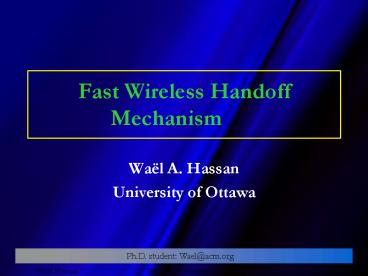Fast Wireless Handoff Mechanism PowerPoint PPT Presentation
1 / 25
Title: Fast Wireless Handoff Mechanism
1
Fast Wireless Handoff Mechanism
- Waël A. Hassan
- University of Ottawa
Ph.D. student Wael_at_acm.org
2
Plan
- Handoff Examples
- GSM
- M-ATM
- Conclusion
- Introduction
- Goal
- Handoffs Vs Mobility Management
- Types of Handoff
3
Handoff
- A handoff mechanism is needed to maintain
connectivity as devices move, while minimizing
disruptions to ongoing transfers. This mechanism
should exhibit low latency, incur little or no
data loss, and scale to a large network.1
Handoff is needed to Maintain Connectivity
4
Achieving Global Mobility
5
A Simple Wireless Network
Mobile Switching Center (MSC)
Mobile Data Set
Base Station Controller (BSC)
PSTN
MobileVoice Unit
Packet Inter-Working Function (IWF)
Base Transceiver System (BTS)
Challenge is to keep connection and not loose any
data during handoff operation
6
Handoff Vs Mobility Management
- Mobile IP handles both local area and wide area
movement in both wired and wireless networks.
However, it requires that a mobiles nodes home
network be notified of every change of location.
Allows users to achieve mobility. However, it is
bandwidth consuming
7
Mobility Management
- Technologies
- GSM and AS41Use HLR and VLR to implement
tracking. - Infrastructures
- Mobile IP and ATM
8
Hierarchical Mobility Management
- Large number of users roam in limited areas
during certain intervals. - Little need to expose the home agent to these
movements. - Mobility management inside domains should be
separate from global mobility management.
Users move in limited areas, no need to notify
home
9
Mobility
- 1st Level Local mobility case handles movement
between base stations wired on the same network.
(connected via Ethernet, bridged Ethernet, or
switched Ethernet) - 2nd level mobility across subnets ( little need
to report to home, required by mobileIP) - Movement across domains. Necessary to inform home
register.
10
Types of Handoff
Handoffs ( Hard Soft )
11
Cross Technology Handoff
Handoffs ( horizontal Vertical )
12
Needs based Handoffs
- Compulsory
- Coverage
- Power Consumption
- Unavailability
- Failure
- Blocking
- Channel Character tics
- Flexible
- Load Balancing
- Speed (limited Number of horizontal handoffs)
- Congestion
Handoffs ( Compulsory Flexible )
13
GSM
- Preparation
- Decision to trigger a handover, and the choice of
target cell are based on the number of parameters
and reasons. - Purpose
- Rescue ( Compulsory or loose connection)
- Confinement ( To optimize the interference)
- Traffic (It is triggered when a cell is congested)
Handoff Handover
14
GSM Handover criteria
- Job of MS and BTS
- Rescue
- quality, path loss, propagation delay.
- Confinement
- Uplink and downlink transmission quality
- Traffic
- Load of each BTS information is Known by MSC and
BSC
Done MSBTS based on Confinement, Traffic, and
Rescue.
15
GSM Handover
- Measurements
- The rate at which measurements are refreshed
should be high. - Execution
- BSC decides to attempt handover.
- A candidate list is chosen
- Actual transfer is negotiated with the old BTS.
The Execution of handover is composed of two main
phases
16
Handover Execution
- It is done in two phases
- Phase I
- OLD-BSC triggers a set of event with the purpose
of establishing communication path. - Phase II
- The mobile station accesses the new channel.
This triggers the switch of paths in the
infrastructure, and the release of the old path.
Handoff happens in two phases
17
Execution
PSTN
PSTN
(MSC)
Mobile Switching Center (MSC)
3
3
2
(BSC)
3
3
1
Packet Inter-Working Function (IWF)
Base Station Controller (BSC)
MobileVoice Unit
Base Transceiver System (BTS)
18
Mobile ATM
- Radio Ports
- Switched and fixed terminalsinterconnected via
access links
Generic Mobile ATM Network
19
Mobile ATM
- Handoff
- Partial Path rerouting
- Path splicing
- Path extension
- ATM level connection terminates at radio port.
- Received traffic forwarded on wireless segment
specific to supported network.
3 ways to do Handoffs Path Rerouting, Splicing,
and extension
20
Handoff Execution
- Handoff Request, Response, Confirm,
- Complete, Join and Join complete.
- It consists of 3 steps
- Selecting a cross over switch and setting up a
new connection segment. - Shifting the data to the crossover switch and
setting up a new connection segment - Extending the connection data path from the new
port to the mobile terminal after it moves under
the radio ports coverage.
21
Handoff Execution
22
Partial Path Rerouting
23
Path Splicing
3
24
Conclusion
- Our Goal is Global Mobility across devices and
network infrastructure. - We have see the different kinds of Handoff or
handover Soft, Hard, Horizontal, Vertical,
Compulsory Flexible - GSM Rescue, Confinement, Traffic
- M-ATM Path Rerouting, splicing, Path Extension
25
Thanks for listening
Wael_at_acm.org

